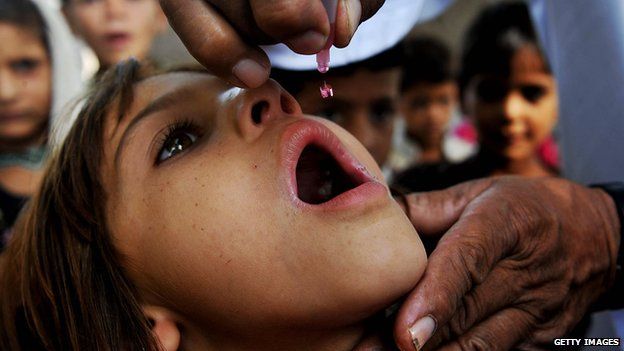Double vaccines 'could hasten the end of polio'
- Published

Using both types of polio vaccine could speed up efforts to free the world of the disease, research suggests.
The oral vaccine is leading the fight to eradicate polio, but trials in India show an additional injection of inactivated virus boosts immunity.
The World Health Organization said the findings, published in the journal Science, were "truly historic".
The disease, which is spread through contaminated faeces, can cause paralysis and even death.
Fighting polio has been one of the biggest success stories in global health.
In 1988, there were 350,000 cases of polio in more than 125 countries.
The disease is now widespread in just three countries - Nigeria, Afghanistan and Pakistan - and cases have fallen by more than 99%.
Vaccines
Two drops of the oral vaccine, which contains a weakened polio virus, is the preferred tool in eradication efforts because it is cheap and gives resistance in the digestive tract to lower transmission of the virus.
The injected vaccine works largely in the bloodstream.
"But the oral vaccine is less effective in exactly those places we'd like it to work," one of the researchers, Prof Nicholas Grassly, of Imperial College London, told the BBC.
It is thought other infections may interfere with the vaccine.
The solution has been multiple vaccination. As part of India's successful eradication campaign, some children received 30 doses by the age of five.
Trials in India showed using an injection of inactivated virus as a booster jab was more effective than multiple drops.
However, the biggest challenge in banishing the disease for good is not the choice of vaccine, but getting to children in conflict-ridden areas.
The security issues can be huge and vaccination programmes are even used as a political weapon.
In 2012, the Taliban said vaccinations in the North and South Waziristan regions of Pakistan were banned until the US ended drone strikes.
Prof Grassly argues: "If you have limited access, you want the biggest return. If you can go in with inactivated and oral polio vaccine, you will achieve a lot more than if you just have brief access with oral polio vaccine."
The double-vaccine approach is already being used in parts of Nigeria and will soon be introduced into Pakistan also.
Dr Bruce Aylward, the World Health Organization assistant director general for polio, said: "The results of this study are truly historic in the context of global polio eradication.
"This study has revolutionised our understanding of inactivated polio vaccine and how to use it in the global eradication effort to ensure children receive the best and quickest protection possible from this disease."
- Published18 May 2014
- Published27 February 2012
- Published20 February 2012
- Published5 May 2014
- Published6 May 2014